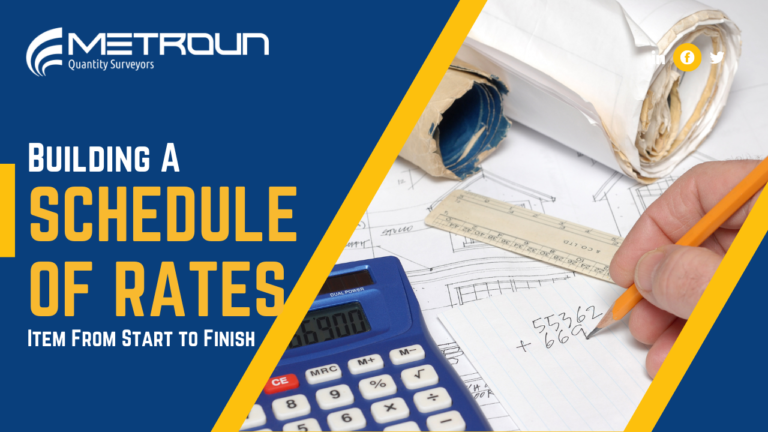In this article, we’ll be exploring the essential process of creating a Schedule of Rates item—a crucial tool in construction when the scope of work is clear, but the exact quantities are uncertain.
Quick disclaimer, the rates & productivity measures in this video are only illustrative, although we’ve tried to keep them realistic. So let’s get started.
Step 1: Defining the Scope
Firstly, let’s define our scope of work: laying a 100mm diameter pipe underground within an asphalt footway. This includes all activities necessary to complete the task, such as:
- Excavation
- Laying Pipe
- Backfilling
- And, Surface Reinstatement
Step 2: Item Cost Elements
Let’s now move on to the cost breakdown, which includes labour, equipment, materials & subcontractors. We’ll base these costs on a standard 10-hour working shift. Cost elements are:
- Labour, which includes:
- Labourer @ £28/hour
- Excavator Operator @ £32/hour
- And 25% Site Supervision @ £11/hour
- Next, we have equipment, which includes:
- 1.5t Excavator & Breaker @ £4/ hour
- Welfare Unit @ £4/hour (including delivery, collection & maintenance)
- Transit Van @ £3/ hour
- Trailer @ £0.50/ hour
This brings the total hourly cost to £82.50 per hour, or £825 per shift.
Next up we have materials & subcontract cost:
- For materials we have:
- 100mm PVC Pipe @ £10/meter
- And finally, Subcontractor cost:
- Where we have reinstatement in asphalt F/W – 500mm wide by 1m deep (including backfill) @ £110/m
We’ve assumed all muckaway, backfill & surface reinstatement will be managed by the reinstatement contractor, small tools & fuel are included within the plant rate and PPE & training is included within the labour rate.
By detailing these costs, we can calculate the direct expense involved in laying each meter of pipe.
Step 3: Productivity
Now, we’ll examine productivity rates to determine how many meters of pipe can be laid per shift. Suppose our crew can install 15 meters per 10-hour shift under normal conditions. This information helps us calculate labour & equipment Cost per Meter: Total labour & equipment cost per shift divided by meters laid.
Understanding productivity is key to accurate scheduling and budgeting.
Step 4: Incorporating Risk Allowance & Fee
We will need to include a risk allowance to account for potential losses or unforeseen issues. This percentage is determined based on the risk profile outlined in the contract and reflects both probable risks and measures taken to mitigate them. In this instance, we’re going to add 5% contingency to cover issues like:
- Unforeseen Ground Conditions or Weather Delays
And finally, we’ll include our fee percentage for overhead and profit. Let’s assume a 10% fee, which covers:
- Corporate Overheads: Administrative expenses, office costs, etc.
- And Profit Margin: The return expected for undertaking the project.
Step 5: Final Rate Calculation
Let’s use everything discussed in previous steps to produce our Schedule of Rates item for laying 100mm pipe.
- Firstly, let’s take our total Labour & plant at £825/ shift
- We now need to turn this into a meter rate using our productivity measure. Earlier, we determined that we could achieve 15m per shift. This would bring our direct labour & plant cost to £55/m
- Let’s now add our material & subcontract cost of £120/m
- This now brings our rate to £175/m
- Let’s add 5% risk, taking our rate to £184/m
- Finally, let’s add our fee for overhead & profit, bringing the final rate to £202/m
Other costs which may need to be considered within the Schedule of Rates item include: preliminaries, site set up/ demobilisation, traffic management, signage, lighting, guarding, permit fees, utility mapping & ground/ environmental surveys. However, these items could be allowed for within standalone extra-over rates.
Introducing Metroun Learning
Metroun Learning is an online education platform, specific to Quantity Surveyors which can satisfy all your formal CPD needs. We offer over 45 hours of formal CPD, with new courses added each month. Although all courses amass to 45 hours of formal CPD, each individual course has been engineered so it can be completed during your lunch break. This can save you time, money & reduce your carbon footprint. Metroun Learning will not only satisfy your formal CPD needs, but you’ll also gain access to:
- The QS Dictionary
- Industry-Ready Templates
- Metroun AI
- And a variety of construction conversion calculators
To join Metroun Learning, simply click here





